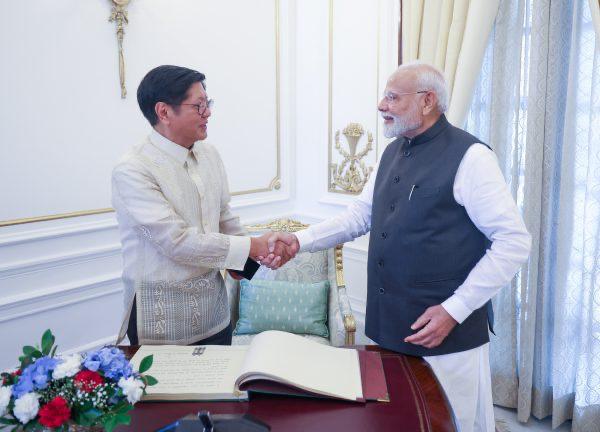 Image Source: The Diplomat
Image Source: The Diplomat
The Philippines’ decision to elevate its relationship with India to a strategic partnership in August 2025 is being described by analysts as a transformative move with significant regional implications. Marked by President Ferdinand Marcos Jr.’s state visit to India, this alliance blends defense, economic, and maritime interests—potentially unsettling China amid mounting tensions in the Indo-Pacific.
Key Highlights: Alliances, Agreements, and Geopolitical Messaging
The strategic partnership was formally declared during President Marcos Jr.’s landmark visit to India, celebrating 75 years of diplomatic ties. Major deliverables included agreements on defense cooperation, maritime security, technology transfer, legal assistance, infrastructure, and even visa-free travel for Indian and Filipino citizens.
A detailed Plan of Action (2025–2029) prioritizes enhanced bilateral cooperation in defense, trade, technology, and connectivity. This includes joint naval exercises in the South China Sea that coincided with the official visit—the first such patrol for both countries in these contested waters.
The Philippines has invited India to participate in large-scale infrastructure projects, while India will share advancements such as the Gatishakti platform and support for a sovereign data cloud in the Philippines.
Bilateral ties will see deeper engagement in cybersecurity, counter-terrorism, energy, agriculture, and digital transformation, reflecting a comprehensive and future-oriented approach to partnership.
Regional Reactions and China’s Growing Unease
Analysts highlight that Manila and New Delhi are responding to shared challenges: both countries face territorial disputes and maritime pressures from China—India along its Himalayan border and the Philippines in the South China Sea.
Chinese state media and officials have sharply criticized the Philippines for “drawing in external countries to stir up trouble”—with Beijing describing India’s involvement in Southeast Asian security as irresponsible and counterproductive. China’s Foreign Ministry stressed: “No third party is in any position to interfere,” referencing joint exercises between India and the Philippines that played out alongside Chinese vessels shadowing the patrols.
Observers warn that China may respond with more aggressive maritime actions and diplomatic pressure following the partnership announcement. The joint concern expressed by Manila and New Delhi over “coercive and aggressive actions” is seen as a direct call-out of Chinese behavior in the broader Indo-Pacific region.
Analysts Weigh In: Strategic Significance and Risks
Diplomacy experts say the upgraded partnership endows the Philippines greater leverage in negotiations and counters China’s dominant posture around disputed territories such as Scarborough Shoal—a frequent flashpoint between Beijing and Manila.
Josue Raphael J. Cortez, a Filipino diplomacy instructor, predicts an uptick in Chinese assertiveness, while geopolitical analysts note that India’s increased sensitivity to Southeast Asian security interests, particularly the Philippines, marks an important recalibration of its foreign policy and Act East strategy.
Both nations are careful to frame their strategic partnership as a commitment to a free, rules-based order in the Indo-Pacific, in line with ASEAN centrality and multilateralism rather than direct military opposition.
Strategic Opportunities: Trade, Technology, and Defense
Economic integration is set to deepen, with the two sides agreeing to advance preferential trade agreements and unlock new collaboration in energy, EVs, digital technologies, and shipbuilding, as well as facilitating Indian investment in Philippine infrastructure and manufacturing.
Routine high-level exchanges and institutional dialogues—the Joint Commission on Bilateral Cooperation, joint working groups, and cross-ministry meetings—will support the early resolution of market access issues and boost bilateral trade, which already reached $3.3 billion in 2024–25.
Navigating the China Challenge: A Broader Impact
The timing of Manila’s pivot to India comes amid persistent doubts about the sustainability of U.S. security guarantees and escalating tensions around Taiwan, giving the Philippines added incentive to hedge its bets and diversify its alliances.
China, watching closely, is expected to monitor future joint exercises, investment flows, and diplomatic outreach between Manila and New Delhi for signs of coordinated resistance to its strategic ambitions in the region.
Conclusion
The Philippines–India strategic partnership is a bold step toward a multipolar Indo-Pacific order, offering Manila a stronger hand in its disputes with China and providing Delhi a greater role in Southeast Asian affairs. While analysts foresee Chinese ire and possible retaliatory measures, both nations are betting on a future of shared security, economic growth, and diplomatic balance—signaling a significant evolution in Asia’s strategic landscape.
Sources: BusinessWorld Online, South China Morning Post
Advertisement
Advertisement






